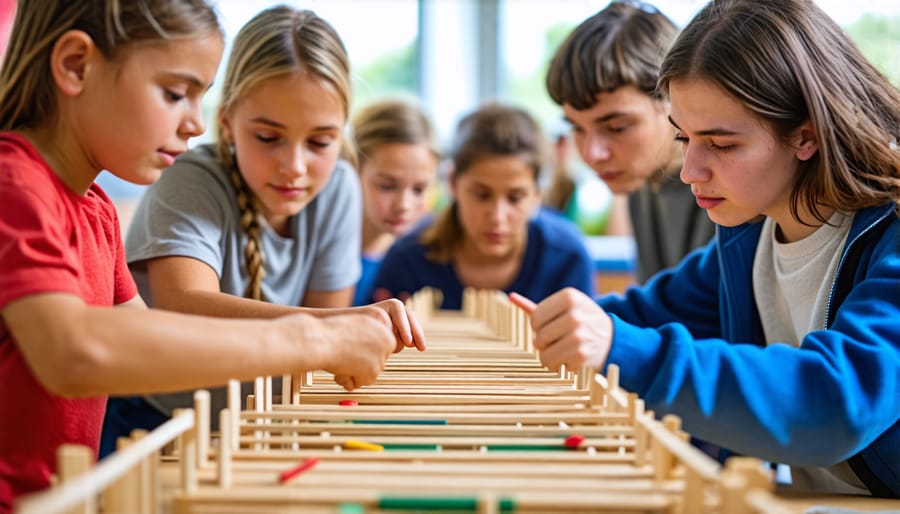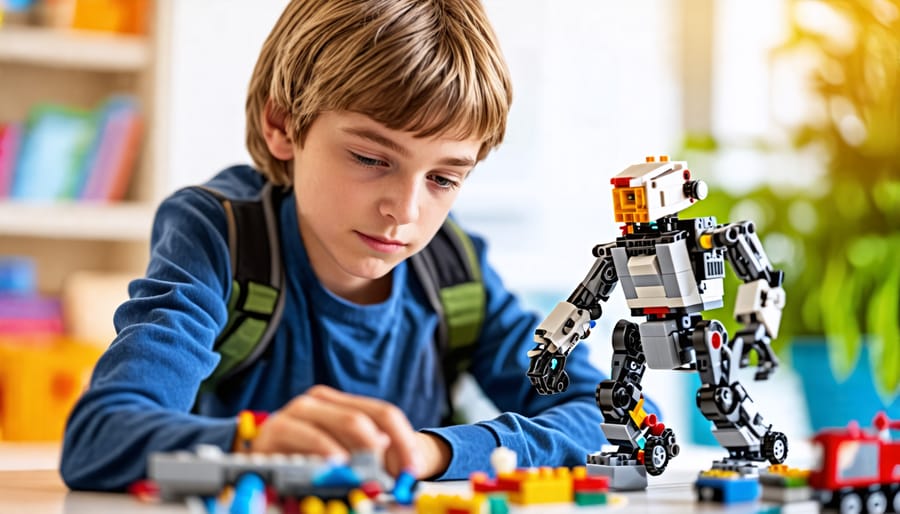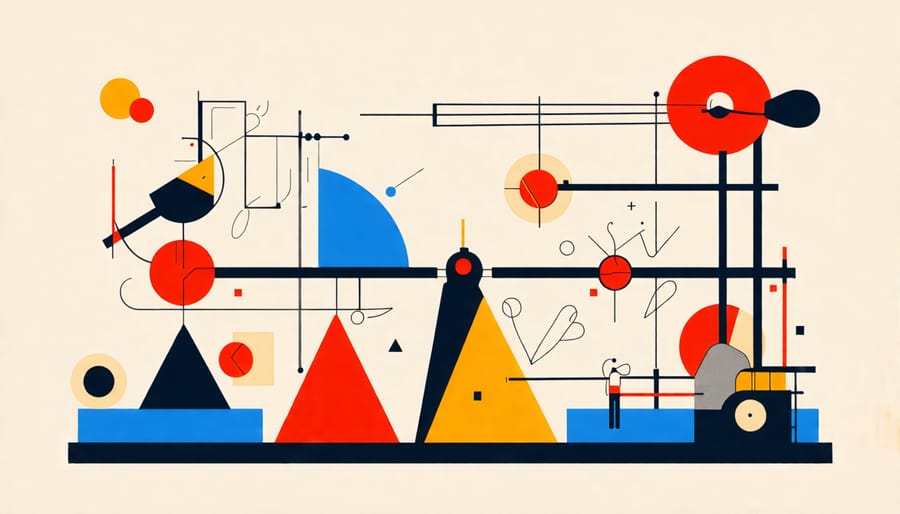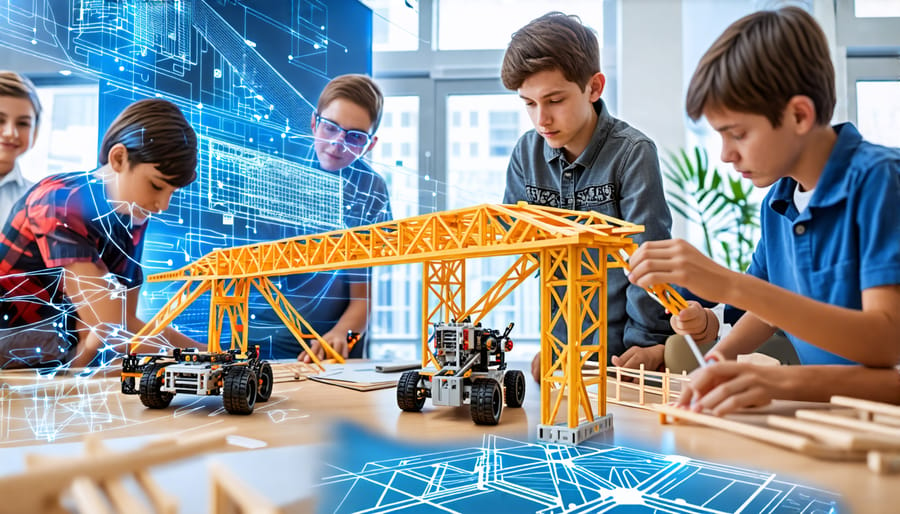Design hands-on building challenges that require students to construct functioning prototypes with limited materials. Gamify the process by scoring designs on criteria like sturdiness, efficiency, and creativity to engage students. Create virtual simulations that allow students to experiment with engineering principles in a risk-free digital environment. Set challenges to optimize designs for specific performance goals. Develop puzzle-based games where students must apply engineering concepts to solve progressively more complex problems. Tie puzzles to real-world scenarios to make the learning relevant and engaging. Organize team-based competitions where student groups race to design, build and test solutions to engineering prompts. Leverage the social dynamics to drive participation and learning.
Bridge Building Challenges
Popsicle Stick Bridges
To build a popsicle stick bridge, start by gathering materials: popsicle sticks, wood glue, cardboard, weights, and a ruler. Create a simple truss design on paper, considering the key structural elements of real bridges. Build two trusses by gluing popsicle sticks into triangular shapes for strength. Cut two longer sticks to go across the top and bottom, connecting the trusses. Glue perpendicular “deck” sticks between the trusses. Allow glue to dry completely, at least 2 hours. Test the bridge by supporting the ends on stacks of books over a gap. Place weights like coins or metal washers on the bridge deck, adding more until structural failure. Record the maximum load held. Students can experiment with different truss designs, heights, and lengths to optimize for strength and efficiency. Discuss which designs perform best and why, connecting to physics and engineering concepts. This hands-on project brings bridge engineering to life.

Virtual Bridge Simulations
Modern digital bridge building games offer an immersive, interactive way for students to learn engineering principles. These virtual simulations allow learners to design and construct bridges in a realistic 3D environment, testing different materials, shapes, and support structures. Advanced physics engines accurately model real-world forces like tension, compression, and wind load, providing immediate feedback on the integrity and efficiency of each design. Compared to physical models, digital bridge games enable rapid iteration and experimentation with complex designs at various scales. They also introduce students to industry-standard software tools and computational methods used by professional engineers. Engaging gameplay elements like challenges, leaderboards, and multiplayer collaboration enhance the learning experience. With the ability to analyze stress points, identify failure modes, and optimize designs, these simulations cultivate critical thinking and problem-solving skills essential for aspiring engineers. Virtual bridge building games represent a powerful, accessible tool for hands-on engineering education in the digital age.
Robotics Challenges

LEGO Robotics
LEGO robotics kits provide an engaging, hands-on introduction to engineering principles for students. The LEGO Mindstorms series, including the latest EV3 set, offers a user-friendly platform for building and programming robots. These kits include motors, sensors, and programmable bricks that allow students to create autonomous robots capable of completing tasks and navigating obstacles. One beginner-friendly robotics game is a line-following challenge, where students program their robots to follow a colored line using light or color sensors. This teaches basic programming concepts and sensor integration. Another game idea is a robot obstacle course, challenging students to build and program robots that can navigate around objects, demonstrating problem-solving skills and spatial awareness. LEGO WeDo 2.0 is another robotics kit well-suited for younger learners, with simpler building components and a drag-and-drop programming interface. Students can design animated models and program them to respond to inputs, fostering creativity and computational thinking. Games like robot soccer or sumo wrestling can be adapted for WeDo, encouraging teamwork and friendly competition. These LEGO robotics games provide a fun, accessible way for students to develop STEM skills, learn programming fundamentals, and explore engineering design processes. With endless possibilities for customization and increasing complexity, LEGO robotics offers a scalable platform for engaging students in engineering.
Advanced Robotics Competitions
For high school and university students passionate about robotics, advanced competitions provide an exciting opportunity to showcase their skills and push the boundaries of engineering. The FIRST Robotics Competition challenges teams of students to design, build, and program industrial-size robots to compete in a challenging field game. With strict rules, limited resources, and tight deadlines, participants gain hands-on experience in engineering design, project management, and teamwork. At the college level, competitions like RoboMaster require teams to construct advanced robots that can navigate complex arenas while engaging in battles and completing tasks. These events test students’ abilities in mechanical design, electronic control systems, autonomous navigation, and strategic decision-making. Participants learn to leverage cutting-edge technologies such as computer vision, machine learning, and sensor fusion to create highly capable robots. Beyond the technical aspects, these competitions foster innovation, creativity, and a competitive spirit. Students learn the importance of collaboration, effective communication, and adaptability as they work together to overcome challenges and achieve their goals. By participating in advanced robotics competitions, aspiring engineers gain invaluable experience that prepares them for successful careers in the rapidly evolving field of robotics and automation.
Energy System Design Games
Energy system design games challenge students to apply their knowledge of thermodynamics, renewable resources, and engineering principles to create virtual power grids that maximize efficiency and minimize environmental impact. These immersive simulations task players with making strategic decisions about energy sources, distribution networks, storage solutions and consumption management to meet the needs of a simulated city or region while adhering to sustainability goals and budgetary constraints. One popular example is “PowerVille”, an online game where students act as energy ministers designing sustainable energy systems for a growing town. They must choose the optimal mix of wind, solar, hydro, geothermal and biomass power to reliably meet demand while reducing emissions. The game introduces realistic challenges like fluctuating fuel prices, public opinion, and extreme weather events that can disrupt the grid. Other energy design games let students compete to create the most efficient energy systems for specific buildings like hospitals, schools or factories. Using drag-and-drop interfaces, players experiment with different HVAC configurations, lighting schemes, insulation materials and renewable microgeneration to minimize the structure’s energy footprint. Real-time feedback displays power consumption, costs, and carbon emissions to highlight the impacts of each design choice. By wrestling with authentic energy dilemmas in a risk-free environment, students develop systems thinking skills and discover clean technology solutions. The game-based format makes learning about energy engaging and interactive, preparing future engineers to solve real-world sustainability challenges. Teachers can also use in-game data to assess understanding and spur thoughtful class discussions about energy innovation.
City Planning Simulations
City planning simulation games provide an immersive way for students to explore urban design and architectural engineering principles. These digital sandboxes allow learners to grapple with the complexities of zoning, infrastructure, transportation networks, and sustainability as they build virtual cities from the ground up. One notable example is the classic city-building series SimCity, which challenges players to manage the intricate systems and competing demands of a growing metropolis. Students must strategically zone residential, commercial and industrial districts, provide essential utilities and services, and adapt to dynamic population and economic fluctuations. Latest entries like SimCity BuildIt further enhance the realism with 3D graphics and touchscreen controls optimized for mobile devices. For a more granular focus on transportation engineering, Cities: Skylines offers robust tools for designing efficient road networks, public transit systems, and pedestrian-friendly spaces. Students can experiment with traffic flow, road hierarchies, and multimodal integration to keep their cities moving. Specialized titles like Urban Plan engage learners in resolving genuine urban redevelopment scenarios, weighing economic, social and environmental considerations. Through role-play and collaboration, students hone vital skills in problem-solving, decision-making and stakeholder negotiation. Across these virtual laboratories, the core goal remains constant: to illuminate the fascinating intricacies of the built environment and inspire the next generation of city-makers. By wrestling with authentic urban challenges in a risk-free digital realm, students cultivate a deeper appreciation for the profound impact of planning and design choices on our shared spaces and quality of life.
Rube Goldberg Machine Contests
Rube Goldberg machine contests challenge students to design and construct elaborate contraptions that perform a simple task through a complex chain reaction. These competitions inspire creative problem-solving and hands-on engineering skills. Participants must adhere to specific rules and constraints while building their machines, often incorporating everyday objects in unconventional ways. The goal is to create a machine with the most steps, transfers of energy, and unique mechanisms while still reliably completing the designated task, such as popping a balloon or turning on a light switch. Judging criteria typically include complexity, reliability, creativity, and adherence to the contest rules. Rube Goldberg contests encourage students to think outside the box, apply physical principles, and iterate on their designs. They provide an engaging platform for students to showcase their ingenuity and engineering prowess while learning valuable lessons in teamwork, project management, and perseverance. These competitions have become increasingly popular at both the high school and college levels, with national contests attracting teams from across the country. Rube Goldberg machine contests offer a fun and challenging way for students to develop practical engineering skills and unleash their creativity in a competitive setting.

Conclusion
Engineering games offer immense potential to engage students, foster critical thinking, and develop vital STEM skills in an interactive, enjoyable way. By seamlessly blending learning objectives with the excitement of gameplay, these activities captivate young minds and inspire a passion for engineering principles. Educators who incorporate well-designed engineering games into their curriculum can expect to see increased student participation, enhanced problem-solving abilities, and a deeper understanding of complex concepts. Moreover, the collaborative nature of many engineering games promotes teamwork, communication, and leadership skills that extend beyond the classroom. As the demand for qualified engineers continues to grow, introducing students to the field through engaging games can spark an early interest and pave the way for future success. We strongly encourage educators to embrace the power of engineering games and make them an integral part of their teaching arsenal. By doing so, they can unlock the full potential of their students and cultivate the next generation of innovative engineers.

